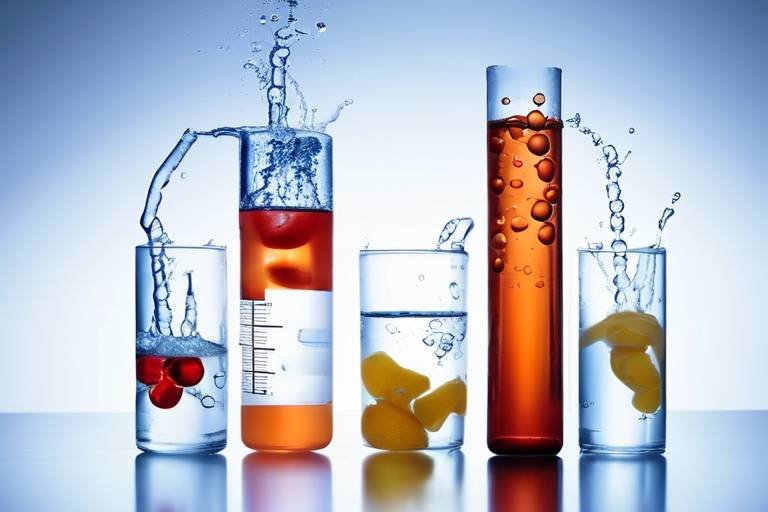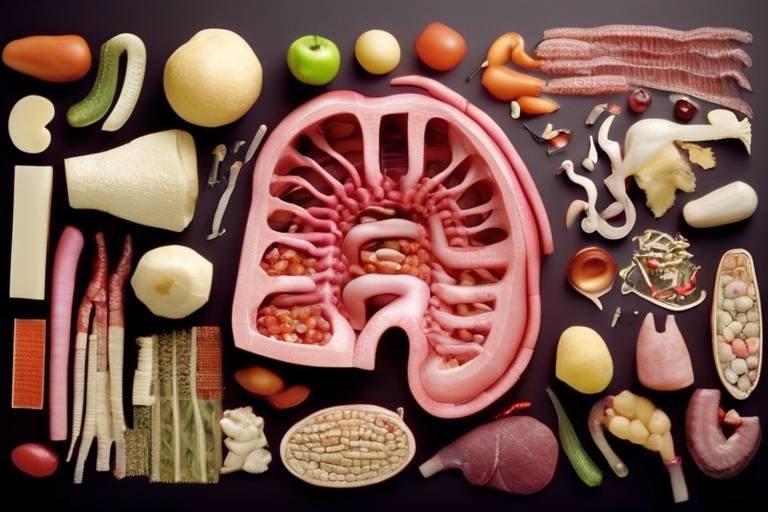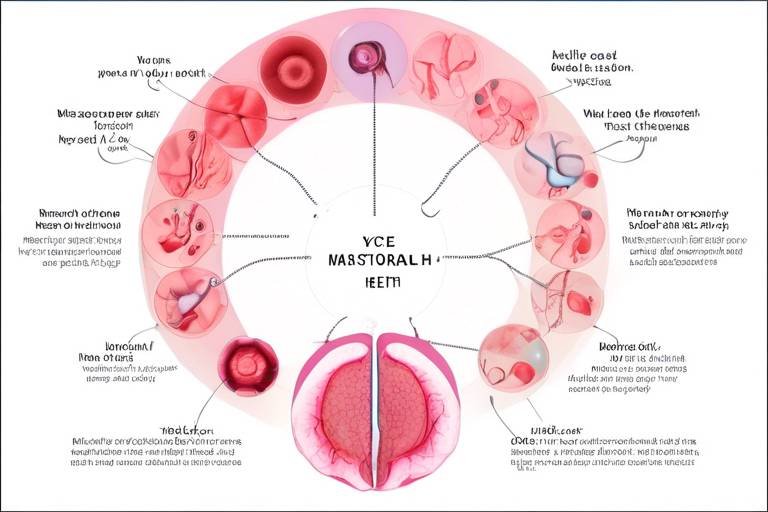The Chemistry of Hydration - Why Water is Essential
Water is not just a simple liquid; it is the lifeblood of our planet. Without it, life as we know it would be impossible. Imagine a world devoid of rivers, oceans, and lakes—sounds like a barren wasteland, right? Water plays a crucial role in biological and chemical processes, acting as a medium for countless reactions that sustain life. Its unique properties, stemming from its molecular structure, make it an extraordinary substance that is vital for all living organisms. In this article, we will explore the multifaceted role of water, from its molecular makeup to its essential functions in biological systems and the environment.
Water's molecular structure is quite fascinating. Composed of two hydrogen atoms bonded to one oxygen atom (H2O), this simple molecule exhibits some of the most unique properties known in chemistry. The polar nature of water molecules leads to the formation of hydrogen bonds, which are responsible for many of water's remarkable characteristics. These bonds give water a high specific heat capacity, allowing it to absorb and retain heat, thus regulating temperatures in our environment. This property is not just a scientific curiosity; it’s crucial for maintaining stable climates and supporting life.
Water is indispensable for various biological processes. It is the medium through which nutrients are transported, waste is eliminated, and biochemical reactions occur. Think of water as the highway of life; without it, the essential traffic of nutrients and energy would come to a halt. Here are some key roles water plays in biological systems:
- Cellular Function: Water maintains cell turgor, which is essential for cells to maintain their shape and function properly.
- Nutrient Transport: Water dissolves essential nutrients, making them accessible to cells for various metabolic processes.
- Temperature Regulation: Water helps regulate body temperature in organisms, ensuring that biochemical processes occur within optimal ranges.
One of the most remarkable features of water is its ability to act as a solvent. Thanks to its polarity, water can dissolve a wide range of substances, which is vital for life. This property enables biochemical reactions to take place within cells, allowing for the necessary interactions between molecules. When nutrients dissolve in water, they can easily move across cell membranes, providing the building blocks for life.
Proper hydration is essential for cellular function. Cells rely on water to maintain their shape and facilitate metabolic processes. Without adequate water, cells can become dehydrated, leading to dysfunction and even cell death. It’s like trying to drive a car without gas; it simply won’t work. Hydration is key to keeping everything running smoothly.
Water is also involved in metabolic reactions, including hydrolysis and dehydration synthesis. Hydrolysis is the process by which water breaks down complex molecules into simpler ones, releasing energy in the process. Conversely, dehydration synthesis involves the removal of water to form new bonds. Both processes are fundamental for energy production and nutrient utilization, highlighting water's critical role in metabolism.
Another important aspect of water is its high specific heat capacity. This property allows organisms to regulate their body temperature effectively. For instance, when you sweat, the evaporation of water from your skin cools you down, providing a stable environment for biochemical reactions to occur. This thermoregulation is vital for survival, especially in extreme temperatures.
Water exhibits several unique properties that contribute to its role in supporting life. These include cohesion, adhesion, and high surface tension. These properties not only make water essential for biological functions but also influence environmental processes.
Cohesion refers to the tendency of water molecules to stick together, while adhesion is the ability of water to cling to other surfaces. These properties are crucial for processes like capillary action in plants, allowing water to travel from roots to leaves. Imagine a straw drawing up water; that’s cohesion and adhesion working together in harmony!
Water's high surface tension enables small organisms, like water striders, to walk on its surface. This phenomenon is not just a quirky fact; it illustrates the unique physical characteristics of water that are vital for ecosystems. Additionally, high surface tension plays a role in water transport in plants, showcasing how water operates on multiple levels in nature.
Beyond its biological importance, water plays a critical role in environmental processes. It influences weather patterns, climate, and ecosystems, highlighting its significance in maintaining ecological balance. The interconnectedness of water with various environmental factors illustrates why it is considered one of the most precious resources on Earth.
The water cycle is a continuous movement of water through evaporation, condensation, and precipitation. This cycle is essential for maintaining ecological balance, ensuring that water is available for all forms of life. It’s a beautiful dance of nature, where water transforms and travels, nourishing the planet.
Unfortunately, water scarcity poses significant challenges to ecosystems and human societies. As populations grow and climate change impacts weather patterns, the demand for water increases. This emphasizes the need for sustainable water management practices to ensure access to this vital resource. Without action, we risk disrupting the delicate balance that water provides to our world.
1. Why is water considered a universal solvent?
Water is termed a universal solvent due to its ability to dissolve a wide range of substances, thanks to its polar nature and hydrogen bonding capabilities.
2. How does water regulate temperature in the body?
Water regulates temperature through its high specific heat capacity, absorbing heat without a significant change in temperature, which helps maintain homeostasis.
3. What happens to cells in a dehydrated state?
When cells are dehydrated, they lose turgor pressure, leading to dysfunction, impaired metabolic processes, and potentially cell death.
4. How does the water cycle affect weather patterns?
The water cycle influences weather patterns by redistributing heat and moisture in the atmosphere, affecting precipitation and temperature across different regions.

Understanding Water's Molecular Structure
Water, a simple yet profoundly important molecule, is composed of two hydrogen atoms and one oxygen atom, forming the chemical formula H2O. This unique arrangement results in a bent molecular geometry, where the angle between the hydrogen-oxygen-hydrogen atoms is approximately 104.5 degrees. But why does this matter? The answer lies in the polar nature of water, which is a direct consequence of its molecular structure.
The oxygen atom is more electronegative than hydrogen, meaning it has a stronger attraction for electrons. This creates a partial negative charge near the oxygen atom and a partial positive charge near the hydrogen atoms. As a result, water molecules exhibit polarity, allowing them to form hydrogen bonds with one another and with other substances. These hydrogen bonds are weak individually, but collectively, they impart significant strength and stability to water, making it a remarkable solvent.
To illustrate the significance of water's molecular structure, consider the following properties:
- Solvent Properties: Water's polarity allows it to dissolve a wide range of substances, from salts to sugars, which is crucial for biochemical reactions in living organisms.
- High Specific Heat: The hydrogen bonds in water require considerable energy to break, which means water can absorb a lot of heat without a significant rise in temperature. This property helps regulate temperatures in the environment and within organisms.
- Density and Ice Formation: Water is unique in that it expands when it freezes, making ice less dense than liquid water. This is why ice floats, providing insulation for aquatic life during cold seasons.
These properties stem from water's molecular structure and play a pivotal role in supporting life on Earth. For example, the ability of water to dissolve nutrients and facilitate chemical reactions is essential for cellular processes. Without water's unique molecular characteristics, life as we know it would be impossible.
In summary, the molecular structure of water is not just a scientific detail; it is the foundation upon which life thrives. Its ability to act as a solvent, regulate temperature, and maintain structural integrity in various forms makes it an indispensable component of biological systems.

The Role of Water in Biological Systems
Water is not just a simple liquid; it is the lifeblood of all living organisms. It plays a crucial role in various biological processes that are essential for sustaining life. From the tiniest bacteria to the largest mammals, every organism relies on water to function properly. Imagine trying to run a car without oil; it simply wouldn't work. Similarly, without water, the intricate machinery of life would grind to a halt.
One of the most significant functions of water in biological systems is its role in cellular function. Cells are like tiny factories, and water is the medium in which all the action happens. It helps maintain cell turgor, which is the pressure of the cell contents against the cell wall. This pressure keeps cells firm and enables them to hold their shape. If you've ever seen a wilted plant, you know that lack of water can lead to a collapse in cellular structure. Proper hydration is essential for cells to perform their duties effectively.
Moreover, water is indispensable for nutrient transport. Think of water as a delivery truck, transporting essential nutrients to various parts of the body. Nutrients dissolve in water, allowing them to be easily absorbed and distributed through the bloodstream. This process is vital for cellular respiration and energy production. Without adequate water, nutrients would struggle to reach their destinations, leading to deficiencies and health issues.
Another critical aspect of water's role in biological systems is its function in temperature regulation. Water has a high specific heat capacity, which means it can absorb a lot of heat without significantly changing temperature. This property is particularly important for organisms that need to maintain a stable internal environment. For example, humans sweat to cool down; the evaporation of sweat from the skin surface helps regulate body temperature. Just as a well-insulated house stays warm in winter, water helps keep organisms at a comfortable temperature, allowing biochemical reactions to proceed smoothly.
Water also participates in various metabolic reactions, including hydrolysis and dehydration synthesis. Hydrolysis is the process of breaking down complex molecules into simpler ones by adding water, while dehydration synthesis involves the removal of water to form new bonds. Both processes are fundamental to energy production and nutrient utilization, highlighting how integral water is to our metabolic pathways.
In summary, water is not merely a component of life; it is a dynamic participant in the biological processes that sustain it. Its unique properties enable it to support cellular function, facilitate nutrient transport, regulate temperature, and participate in metabolic reactions. Without water, life as we know it would be impossible.
- Why is water essential for life? Water is vital for cellular function, nutrient transport, and regulating body temperature, among other biological processes.
- How does water help in nutrient transport? Water dissolves nutrients, allowing them to be easily absorbed and transported throughout the body.
- What happens to cells without water? Cells can lose their shape and function, leading to wilting in plants and various health issues in animals.
- Can organisms survive without water? No, all known forms of life depend on water to carry out essential biological functions.

Water as a Solvent
Water is often referred to as the "universal solvent," and for good reason! Its unique molecular structure allows it to dissolve a wide variety of substances, making it an essential component in countless biological and chemical processes. The polarity of water molecules, which means they have a slight positive charge on one end and a slight negative charge on the other, enables them to interact with various ions and molecules. This property is crucial for facilitating biochemical reactions within our cells.
When we think about how water acts as a solvent, it’s helpful to visualize it as a busy marketplace where different substances come to interact. Just as vendors and customers exchange goods, water molecules surround and interact with solutes, breaking them apart and allowing them to disperse evenly throughout a solution. This is vital for the transport of nutrients and waste products in living organisms. For instance, when we eat, our bodies rely on water to dissolve vitamins, minerals, and glucose, allowing them to be absorbed into our bloodstream and delivered to cells that need them.
Moreover, the ability of water to dissolve substances is not just limited to nutrients. It also plays a significant role in metabolic processes. Imagine water as a skilled chef in a kitchen, expertly mixing ingredients to create a perfect dish. In the same way, water participates in chemical reactions, such as hydrolysis, where it helps break down complex molecules into simpler ones. This is essential for energy production and the utilization of nutrients in our bodies.
To illustrate the importance of water as a solvent, let's consider a simple table that outlines some common substances dissolved in water:
| Substance | Type | Significance |
|---|---|---|
| Salt (NaCl) | Ionic | Essential for nerve function and muscle contraction |
| Sugars (e.g., glucose) | Polar | Provides energy for cellular processes |
| Amino Acids | Polar/Non-polar | Building blocks of proteins |
| Oxygen (O2) | Non-polar | Critical for cellular respiration |
This table highlights just a few examples of the myriad substances that water can dissolve, each playing a critical role in maintaining life. Without water's remarkable solvent capabilities, the intricate dance of life as we know it would simply not be possible.
In conclusion, water’s role as a solvent is not just a scientific concept; it’s a fundamental aspect of life. From aiding in digestion to facilitating energy production, the ability of water to dissolve various substances underscores its importance in biology and chemistry. So, the next time you take a sip of water, remember that you’re not just hydrating; you’re also fueling countless vital processes that keep you alive and thriving!

Hydration and Cellular Function
When we talk about hydration, we're not just discussing the act of drinking water; we're diving into a fundamental aspect of life itself. Water is the silent hero in the story of cellular function. Imagine your cells as tiny factories, bustling with activity, where every worker needs a reliable supply of resources to function efficiently. Without adequate hydration, these factories can quickly fall into disarray.
To understand why hydration is so essential, let’s consider the role of water in maintaining cell turgor. Turgor pressure is like the air in a balloon; it keeps the cell firm and structured. When a cell is well-hydrated, it swells slightly, pushing against the cell wall, which helps maintain its shape and function. However, when water levels drop, cells can become flaccid, leading to a host of issues, including impaired nutrient transport and reduced metabolic activity.
Moreover, hydration plays a crucial role in metabolic processes. Water is not just a passive participant; it actively engages in biochemical reactions. For instance, during hydrolysis, water molecules break down complex molecules into simpler ones, releasing energy that cells need to perform their functions. This process is vital for everything from digestion to energy production. It’s fascinating to think about how something as simple as water can be the catalyst for life-sustaining reactions!
Furthermore, hydration is essential for transporting nutrients across cell membranes. Think of water as the delivery truck of the cellular world, carrying essential nutrients and waste products in and out of cells. Without sufficient water, these delivery trucks can get stuck in traffic, leading to nutrient deficiencies and the accumulation of harmful waste. This can be particularly detrimental in environments where cells are rapidly dividing or when they are under stress, such as during exercise or illness.
In summary, maintaining proper hydration is not merely a recommendation; it is a necessity for optimal cellular function. A well-hydrated body ensures that cells can perform their tasks efficiently, maintain their structure, and engage in vital metabolic processes. So, the next time you reach for a glass of water, remember that you’re not just quenching your thirst; you’re fueling your cellular engines and keeping your body running smoothly.
- How much water should I drink daily? The general guideline is to aim for about 8-10 cups of water a day, but individual needs can vary based on factors like activity level and climate.
- Can I hydrate with beverages other than water? Yes! While water is the best option, other beverages like herbal teas and even fruits and vegetables with high water content can contribute to your hydration.
- What are the signs of dehydration? Common signs include thirst, dry mouth, fatigue, dizziness, and dark-colored urine. If you experience these symptoms, it’s important to drink water promptly.

Water's Role in Metabolism
Water is not just a thirst quencher; it’s a crucial player in the intricate dance of metabolism that keeps our bodies humming. Think of water as the unsung hero in the story of life, tirelessly working behind the scenes to ensure that every biochemical reaction occurs smoothly. Without this vital liquid, our cells would struggle to perform the essential processes that sustain life.
At the heart of metabolism are two fundamental reactions: hydrolysis and dehydration synthesis. Hydrolysis is the process by which larger molecules are broken down into smaller units, and guess what? Water is a key ingredient in this reaction. For instance, when we consume carbohydrates, proteins, or fats, hydrolysis helps to break these macromolecules down into glucose, amino acids, and fatty acids, respectively. This breakdown is essential for energy production and nutrient absorption in our bodies.
On the flip side, we have dehydration synthesis, where smaller molecules come together to form larger ones, and here again, water plays a pivotal role. During this process, water molecules are removed as new bonds are formed, allowing our bodies to build complex molecules like proteins and polysaccharides that are crucial for cellular structure and function. It’s like assembling a puzzle; you need the right pieces to fit together, and water helps facilitate that connection.
Moreover, water acts as a medium for transporting nutrients and waste products within our bodies. Imagine water as a bustling highway, carrying essential nutrients to cells while whisking away waste products for excretion. This transportation system is vital for maintaining cellular health and ensuring that metabolic processes run efficiently. Without sufficient water, the traffic can get jammed, leading to a buildup of toxins and a slowdown in metabolic functions.
To further illustrate the importance of water in metabolism, let’s take a look at the following table that summarizes its roles:
| Metabolic Process | Role of Water |
|---|---|
| Hydrolysis | Breaks down macromolecules into smaller units, facilitating energy release. |
| Dehydration Synthesis | Joins smaller molecules to form larger ones, essential for building cellular structures. |
| Nutrient Transport | Acts as a medium for transporting nutrients to cells and waste products away. |
In summary, water is indispensable for metabolism, serving as a reactant, product, and solvent in various biochemical reactions. Whether it’s breaking down food, building new molecules, or transporting vital substances, water is the life-giving force that keeps our metabolic engines running smoothly. So, next time you take a sip, remember that you’re not just hydrating; you’re fueling the very processes that sustain your life.
- Why is water essential for metabolism? Water is crucial for biochemical reactions, acting as a reactant in hydrolysis and dehydration synthesis, and facilitating nutrient transport.
- How does dehydration affect metabolism? Dehydration can slow down metabolic processes, leading to a buildup of toxins and reduced energy production.
- Can I get enough water from food? While food can contribute to hydration, it’s important to drink sufficient water to meet your body’s metabolic needs.

Thermoregulation and Water
Water is not just a refreshing drink; it is a crucial player in the game of life, especially when it comes to thermoregulation. Imagine your body as a finely tuned machine, and water is the coolant that keeps everything running smoothly. The high specific heat capacity of water means it can absorb a lot of heat without a significant rise in temperature. This property is essential for organisms, allowing them to maintain a stable internal environment, regardless of external conditions.
For example, when the temperature rises, water in our bodies absorbs excess heat, preventing our internal temperature from skyrocketing. This process is vital for enzymatic reactions that occur within our cells, as most of these reactions are temperature-sensitive. If our body temperature fluctuates too much, it can lead to metabolic chaos, making it hard for our cells to function properly. Think of it as trying to cook a meal at an inconsistent temperature; the results would be unpredictable!
Furthermore, water plays a significant role in the cooling mechanisms of various organisms. For humans, sweating is one of the most effective ways to regulate body temperature. As sweat evaporates from the skin's surface, it takes heat with it, effectively cooling the body down. This natural air conditioning system relies heavily on water, demonstrating how intertwined hydration and thermoregulation truly are.
In the animal kingdom, different species have adapted unique methods for thermoregulation that also rely on water. For instance, elephants use their large ears to dissipate heat, while camels can tolerate significant fluctuations in body temperature, conserving water during the hottest parts of the day. These adaptations highlight the importance of water not just for survival, but for thriving in diverse environments.
To illustrate the importance of water in thermoregulation, consider the following table that showcases how different organisms utilize water for temperature control:
| Organism | Method of Thermoregulation | Role of Water |
|---|---|---|
| Humans | Sweating | Evaporation of sweat cools the body |
| Elephants | Large ears for heat dissipation | Water in the body helps maintain temperature |
| Camels | Tolerance to temperature fluctuations | Conserves water to prevent overheating |
In conclusion, the relationship between water and thermoregulation is a fascinating aspect of biology that underscores the importance of hydration. Without adequate water, our bodies—and those of countless other organisms—would struggle to maintain a stable internal environment, which is vital for survival. So, the next time you take a sip of water, remember that you are not just quenching your thirst; you are also ensuring that your body can efficiently regulate its temperature, keeping you cool and collected in any situation.
- Why is water essential for thermoregulation? Water helps maintain a stable internal temperature by absorbing heat and facilitating cooling processes like sweating.
- What happens if we don't drink enough water? Dehydration can lead to overheating, impaired metabolic functions, and overall reduced efficiency of the body's systems.
- How do different animals regulate their temperature using water? Animals have various adaptations, such as sweating, evaporative cooling, and unique body structures, to manage their body temperature effectively.

Water's Unique Properties
Water is not just a simple molecule; it is a remarkable substance that exhibits a variety of unique properties essential for life. One of the most fascinating aspects of water is its polarity. This means that water molecules have a slight positive charge on one side and a slight negative charge on the other, allowing them to form hydrogen bonds with each other and with other substances. This property is what makes water an excellent solvent, capable of dissolving a wide range of substances. Imagine water as a universal connector, bringing together nutrients and chemicals necessary for biological processes.
Another unique property of water is its cohesion and adhesion. Cohesion is the tendency of water molecules to stick to themselves, which creates surface tension. This is why you can see water droplets forming on a leaf or a spider walking on water without sinking. On the flip side, adhesion allows water to cling to other surfaces, which is crucial for processes like capillary action in plants. This action helps water travel from the roots to the leaves, demonstrating how water's properties are intricately linked to life on Earth.
Moreover, water has a high specific heat capacity, which means it can absorb a lot of heat before its temperature changes significantly. This property is vital for thermoregulation in living organisms. For instance, humans rely on water to regulate body temperature through sweating. When sweat evaporates from the skin, it takes heat away, helping to cool the body down. This is akin to using a fan on a hot day; the water in our bodies acts as a natural coolant.
Water's high surface tension is another standout characteristic. This property not only supports small organisms like water striders but also plays a role in the transport of water in plants. The high surface tension created by cohesive forces allows water to move through tiny vessels in plants, defying gravity in a process known as transpiration. Without this unique property, plants would struggle to survive, showcasing how water's physical characteristics are crucial for ecosystems.
Lastly, water's ability to exist in three states—solid, liquid, and gas—at temperatures found on Earth is quite extraordinary. This versatility allows for various environmental processes, such as the formation of clouds and precipitation. The transition of water from ice to liquid to vapor is a continuous cycle that influences weather patterns and climate. It's as if water is playing a never-ending game of musical chairs, constantly changing its form and contributing to the dynamic systems of our planet.
- What is the most important property of water? Water's polarity is crucial as it enables it to dissolve many substances, making it essential for biochemical reactions.
- How does water's high specific heat capacity affect the environment? It helps regulate temperatures in bodies of water, providing a stable environment for aquatic life.
- Why is water's surface tension important? It allows small organisms to walk on water and aids in the movement of water within plants.

Cohesion and Adhesion
Water is a remarkable substance, and its cohesion and adhesion properties are fundamental to understanding how it supports life on Earth. Cohesion refers to the tendency of water molecules to stick to one another, creating a strong bond due to the hydrogen bonds formed between them. This property is what allows water to form droplets, and it plays a crucial role in various biological and environmental processes. For example, when you see water pooling on a surface, it's a testament to its cohesive nature, which is strong enough to resist gravity to some extent.
On the other hand, adhesion is the property that allows water molecules to stick to other substances. This is equally vital, especially in biological systems. Think of how water travels up a plant stem against the force of gravity. This phenomenon occurs due to adhesion, where water molecules cling to the walls of the xylem vessels, allowing them to be transported from the roots to the leaves. Without this property, plants would struggle to survive, as they rely on water for photosynthesis and nutrient transport.
The combination of cohesion and adhesion leads to a process known as capillary action. This is particularly evident in small tubes or porous materials, where water can move upward against gravity. Imagine a thin straw placed in a glass of water; the water rises in the straw due to these two properties working together. This is not just a fascinating physical phenomenon; it is essential for the survival of plants and the ecosystems they support.
To illustrate the importance of cohesion and adhesion, consider the following table that highlights their key differences and roles in nature:
| Property | Description | Example |
|---|---|---|
| Cohesion | The attraction between water molecules. | Water droplets forming on a leaf. |
| Adhesion | The attraction between water molecules and different substances. | Water climbing up a plant's stem. |
In summary, the cohesive and adhesive properties of water are not just scientific curiosities; they are vital mechanisms that facilitate life. They enable plants to absorb water and nutrients efficiently, support various biological functions, and maintain ecological balance. Without these properties, life as we know it would be drastically different, underscoring the significance of water in our world.
- What is cohesion in water? Cohesion is the tendency of water molecules to stick together due to hydrogen bonding.
- How does adhesion benefit plants? Adhesion allows water to cling to plant surfaces, aiding in nutrient transport and capillary action.
- Why is water's high surface tension important? High surface tension supports small organisms and enables water transport in plants.
- Can cohesion and adhesion be observed in everyday life? Yes! You can see these properties in action when water beads on a car's surface or when it rises in a straw.

High Surface Tension
Water's is one of its most fascinating properties, and it plays a crucial role in various natural processes. This phenomenon occurs because water molecules are strongly attracted to each other due to hydrogen bonding. Imagine a group of friends holding hands tightly; they form a solid line that is difficult to break. Similarly, water molecules cling together, creating a sort of "skin" on the surface of the water. This is why small insects like water striders can walk on water without sinking. It's almost like they are skating on a frozen lake, where the surface tension provides just enough support to keep them afloat.
But the implications of high surface tension extend far beyond just supporting tiny insects. In plants, this property is vital for capillary action, which allows water to move from the roots to the leaves. The cohesion between water molecules pulls them upward against gravity, enabling the plant to transport nutrients effectively. Without this unique characteristic, plants would struggle to survive, and our ecosystems would be drastically different. Think of surface tension as the invisible thread that connects the water in the soil to the leaves at the top of a towering tree.
Furthermore, the high surface tension of water also plays a significant role in various environmental processes. For instance, it helps in the formation of droplets during precipitation. When clouds gather moisture, the water molecules stick together to form larger droplets, which eventually fall as rain. This process is essential for replenishing water sources and maintaining ecological balance. Without high surface tension, raindrops would not form effectively, leading to a less efficient water cycle.
In summary, the high surface tension of water is not just a trivial characteristic; it is a fundamental aspect that supports life on Earth. Whether it is aiding in plant hydration or influencing weather patterns, this property is a testament to the unique chemistry of water. It reminds us of how interconnected natural processes are and how crucial water is for sustaining life. In a world where every drop counts, understanding these properties can help us appreciate the delicate balance of our ecosystems.
- What causes water's high surface tension?
Water's high surface tension is primarily due to the strong hydrogen bonds between water molecules, which create a cohesive force that holds them together.
- How does surface tension affect aquatic life?
High surface tension allows small organisms, like water striders, to walk on water and supports various ecological interactions within aquatic environments.
- Can surface tension change?
Yes, surface tension can change due to the presence of impurities or surfactants, which can lower the surface tension and affect water's behavior.

Water in the Environment
Water is not just a fundamental resource for life; it is also a powerful force that shapes our environment. From the vast oceans to the tiniest streams, water plays a critical role in various ecological processes. It acts as a medium for transporting nutrients, regulating temperatures, and supporting diverse ecosystems. Have you ever thought about how a single drop of water can impact the world around it? The interconnectedness of water with the environment is nothing short of fascinating.
One of the most significant aspects of water in the environment is its role in weather patterns and climate. The movement of water through the water cycle—which includes processes like evaporation, condensation, and precipitation—helps to distribute heat and energy around the planet. This cycle not only influences local weather but also contributes to global climate dynamics. For example, areas near large bodies of water tend to have milder climates, while regions further inland can experience more extreme temperatures. It’s like nature’s way of balancing the scales, ensuring that no part of the Earth becomes too hot or too cold.
Additionally, water bodies such as lakes, rivers, and wetlands serve as habitats for countless species. These ecosystems are vital for maintaining biodiversity, providing food, shelter, and breeding grounds for various organisms. In fact, many species rely on aquatic environments for their survival. Without water, these ecosystems would collapse, leading to a cascade of negative effects on the food chain and overall ecological balance. For instance, wetlands act as natural filters, purifying water and providing critical services like flood control and carbon storage.
However, the significance of water goes beyond its biological functions. It is also a key player in shaping landscapes. Erosion, sedimentation, and weathering processes are all influenced by the presence of water. Rivers carve valleys, while glaciers sculpt mountains, showcasing the sheer power of water in shaping the Earth's surface. Think of water as an artist, continuously molding and redefining the world we live in.
Despite its abundance, water scarcity is an increasingly pressing issue that affects both ecosystems and human societies. Factors such as climate change, pollution, and over-extraction of water resources threaten the availability of this precious commodity. As populations grow and industrial demands increase, the pressure on water resources intensifies. It's crucial for communities to adopt sustainable water management practices to ensure that future generations have access to clean, safe water. This includes:
- Implementing water conservation techniques
- Protecting watersheds and natural water sources
- Promoting responsible agricultural practices
In conclusion, water is an indispensable element of our environment, influencing everything from climate to biodiversity. Its complex interactions within ecosystems highlight the need for responsible stewardship of this vital resource. As we continue to face challenges related to water scarcity and pollution, understanding the multifaceted role of water in the environment becomes more important than ever.
- What is the water cycle? The water cycle is the continuous movement of water through evaporation, condensation, and precipitation, playing a crucial role in regulating climate and supporting ecosystems.
- How does water impact climate? Water bodies influence local and global climates by distributing heat and moisture, affecting weather patterns and temperature variations.
- Why is water conservation important? Water conservation is essential to ensure the availability of clean water for future generations and to protect ecosystems from the impacts of water scarcity.

The Water Cycle
The water cycle, often referred to as the hydrological cycle, is a captivating and continuous process that describes the movement of water within the Earth and its atmosphere. This cycle is not only essential for maintaining ecological balance but also plays a crucial role in supporting life. Imagine it as a grand performance, where water takes on various roles—evaporating into the sky, condensing into clouds, and finally falling back to the Earth as precipitation. Each phase of this cycle is interconnected, creating a dynamic system that sustains both natural ecosystems and human activities.
At the heart of the water cycle are several key processes:
- Evaporation: This is the stage where water transforms from liquid to vapor, primarily due to heat from the sun. Bodies of water such as oceans, lakes, and rivers are the main contributors to this process.
- Condensation: As water vapor rises, it cools and condenses into tiny droplets, forming clouds. This process is crucial as it signifies the transition from vapor back to liquid.
- Precipitation: Eventually, the droplets coalesce and fall back to the Earth in the form of rain, snow, sleet, or hail, replenishing water sources.
- Infiltration and Runoff: Once the precipitation reaches the ground, some of it soaks into the soil (infiltration), while the rest flows over the surface (runoff) into rivers, lakes, and oceans, continuing the cycle.
This cycle is not just a local phenomenon but a global one, impacting weather patterns and climate across different regions. For instance, areas with abundant water bodies experience higher rates of evaporation, leading to increased cloud formation and precipitation. Conversely, arid regions see less evaporation and, consequently, less rainfall, which affects their ecosystems and human livelihoods.
Moreover, the water cycle is vital for maintaining freshwater supplies. It ensures that rivers and lakes are replenished, which is essential for drinking water, agriculture, and industry. The cycle's efficiency is a testament to nature's ability to recycle and distribute this precious resource. However, human activities, such as deforestation and pollution, can disrupt this delicate balance, leading to consequences like droughts or flooding.
In summary, the water cycle is a remarkable system that illustrates the interconnectedness of our planet's processes. It reminds us of the importance of water conservation and sustainable practices to protect this vital resource for future generations.
- What are the main stages of the water cycle?
The main stages are evaporation, condensation, precipitation, infiltration, and runoff. - How does the water cycle affect climate?
The water cycle influences weather patterns and climate by regulating temperature and precipitation levels. - Why is the water cycle important for ecosystems?
It maintains freshwater supplies, supports plant and animal life, and regulates environmental conditions. - How can human activities impact the water cycle?
Deforestation, pollution, and urbanization can disrupt the natural processes of the water cycle, leading to issues like droughts and floods.

Impact of Water Scarcity
Water scarcity is not just a buzzword; it’s a pressing reality that affects millions of people around the world. Imagine waking up in the morning and not being able to turn on the tap for a glass of water. Frightening, right? This scenario is becoming increasingly common in many regions, and the implications are staggering. When we talk about water scarcity, we're referring to both physical scarcity—where water availability is limited—and economic scarcity, where access to water is hindered due to infrastructure issues or high costs.
The impact of water scarcity extends far beyond just thirst. It can lead to a cascade of challenges that affect health, agriculture, and even economic stability. For instance, without sufficient water, crops cannot grow, leading to food shortages. This is particularly alarming because agriculture is a major consumer of fresh water, accounting for about 70% of global freshwater use. When farmers can’t irrigate their fields, it doesn’t just hurt their livelihoods; it affects the entire food supply chain.
Moreover, water scarcity can exacerbate existing inequalities. Communities that are already disadvantaged may find themselves in a dire situation when water becomes even more scarce. This can lead to increased competition for resources, resulting in social unrest and conflict. In some regions, this has already been seen, where disputes over water rights have escalated into violent confrontations.
To illustrate the severity of this issue, consider the following statistics:
| Region | Population Affected by Water Scarcity | Projected Increase by 2025 |
|---|---|---|
| Sub-Saharan Africa | 300 million | 50% |
| Middle East & North Africa | 60% of the population | 70% |
| South Asia | 600 million | 40% |
As you can see, the numbers are alarming. But what can we do about it? Addressing water scarcity requires a multifaceted approach. Here are a few strategies:
- Investing in Water Infrastructure: Improving the systems that deliver water can reduce waste and ensure that more people have access.
- Promoting Sustainable Water Use: Encouraging practices like rainwater harvesting and efficient irrigation methods can help conserve this precious resource.
- Raising Awareness: Education plays a crucial role. By informing communities about the importance of water conservation, we can foster a culture that values this vital resource.
In conclusion, the impact of water scarcity is profound and far-reaching. It’s not just about having enough water to drink; it’s about ensuring a sustainable future for all. As we face this challenge, it's imperative to recognize the interconnectedness of water with health, food security, and social stability. Only through collective action can we hope to mitigate the effects of water scarcity and secure a better future for ourselves and generations to come.
Q: What are the main causes of water scarcity?
A: Water scarcity can be attributed to several factors, including climate change, population growth, pollution, and inefficient water management practices.
Q: How can individuals help combat water scarcity?
A: Individuals can help by conserving water at home, fixing leaks, using water-efficient appliances, and being mindful of their water usage.
Q: What role does agriculture play in water scarcity?
A: Agriculture is a significant consumer of freshwater resources. Inefficient irrigation practices can lead to excessive water use, exacerbating water scarcity issues.
Q: Are there technologies available to address water scarcity?
A: Yes, technologies such as desalination, water recycling, and advanced irrigation systems can help alleviate water scarcity by providing alternative sources of water and improving efficiency.
Frequently Asked Questions
- Why is water so important for life?
Water is the cornerstone of life on Earth. It plays a critical role in various biological processes, such as cellular function, nutrient transport, and temperature regulation. Without water, living organisms would struggle to survive, as it facilitates essential chemical reactions necessary for life.
- What makes water's molecular structure unique?
Water consists of two hydrogen atoms and one oxygen atom, creating a polar molecule. This polarity gives water its exceptional properties, including its ability to dissolve many substances, which is vital for biochemical reactions in living organisms.
- How does water contribute to metabolic processes?
Water is involved in crucial metabolic reactions, including hydrolysis and dehydration synthesis. These processes help in breaking down nutrients for energy and building larger molecules, showcasing water's vital role in energy production and nutrient utilization.
- What is the significance of water's high specific heat capacity?
Water's high specific heat capacity allows organisms to maintain stable internal temperatures despite external changes. This stability is essential for creating a conducive environment for biochemical reactions, ensuring that life can thrive.
- How does water facilitate plant growth?
Water's cohesive and adhesive properties are crucial for processes like capillary action, which allows water to travel from the roots to the leaves of plants. This movement not only provides necessary hydration but also helps in nutrient transport, promoting overall plant health.
- What impact does water scarcity have on ecosystems?
Water scarcity can lead to significant challenges for both ecosystems and human societies. It disrupts the balance of natural habitats, affects wildlife, and can lead to food shortages. Sustainable water management practices are essential to ensure that this vital resource is available for future generations.
- Can you explain the water cycle?
The water cycle is a continuous process that describes the movement of water through evaporation, condensation, and precipitation. This cycle is crucial for maintaining ecological balance, as it regulates weather patterns and supports various ecosystems.



















